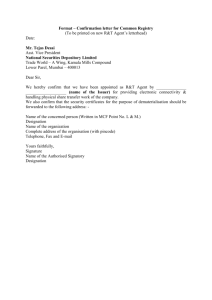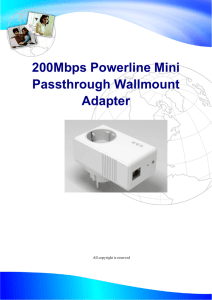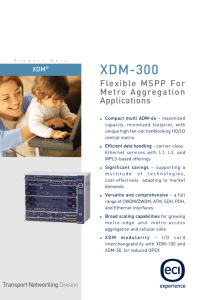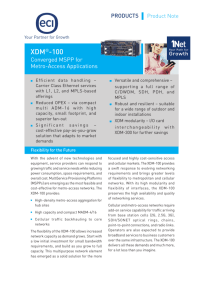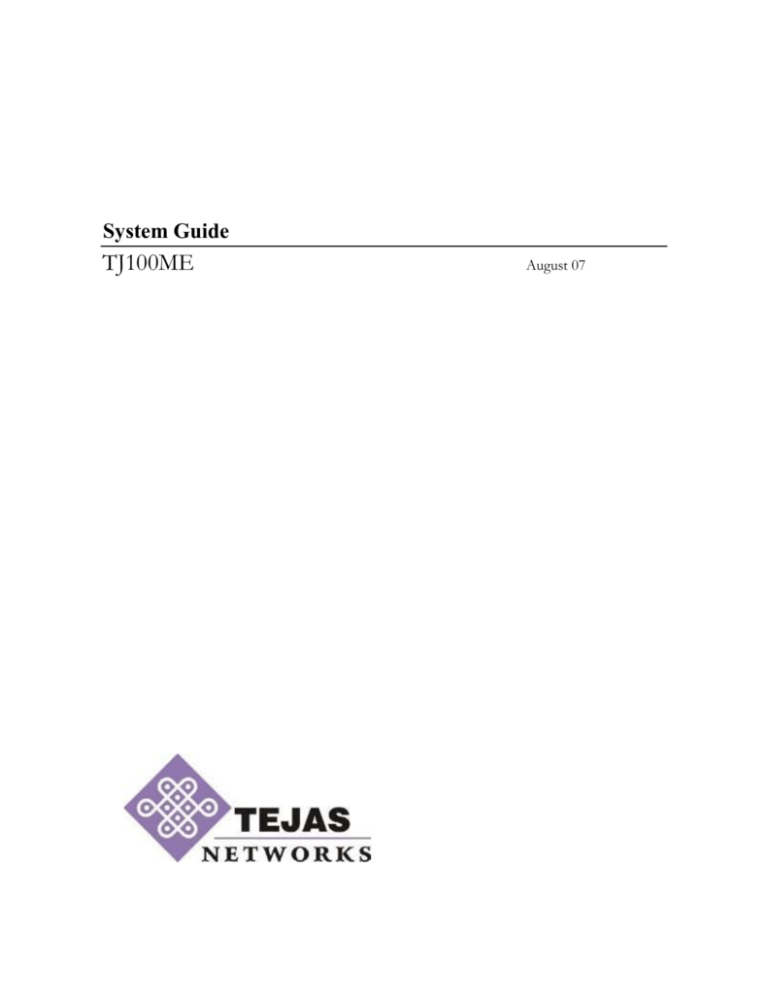
System Guide
TJ100ME
August 07
TJ100ME System Guide
Version 1.0
August 07
Revision history
Revision
Date
1.0
30-04-2006
Comments
© Copyright by Tejas Networks India Ltd 2000-2007. All Rights
Reserved worldwide.
This document contains information that is the property of Tejas
Networks India Ltd. This document may not be copied, reproduced,
reduced to any electronic medium or machine readable form, or
otherwise duplicated, and the information herein may not be used,
disseminated or otherwise disclosed, except with the prior written
consent of Tejas Networks India Ltd.
Tejas Networks India Ltd reserves the right, without prior notice or
liability, to make changes in equipment design or specifications
Table of Contents
INTRODUCTION ........................................................................................................................................3
Architectural Details....................................................................................................................................4
Key Features ..............................................................................................................................................4
Multi-service Platform: ................................................................................................................................5
Flexibility:....................................................................................................................................................5
Protection: ..................................................................................................................................................5
Configuration: .............................................................................................................................................5
Cross-connect Capability:...........................................................................................................................5
Miniature Size:............................................................................................................................................5
Synchronization: .........................................................................................................................................5
Laser Protection: ........................................................................................................................................5
SYSTEM OVERVIEW ................................................................................................................................6
Chassis/Backplane .....................................................................................................................................6
OAM Card...................................................................................................................................................6
Tributary Cards...........................................................................................................................................7
28xE1/DS1 Tributary Card .........................................................................................................................7
63xE1/DS1 Tributary Card .........................................................................................................................7
3xE3/DS3 Tributary Card ...........................................................................................................................7
2xSTM-1/OC-3 Tributary Card ...................................................................................................................7
8-port 10/100 Base-T Ethernet Transport Card..........................................................................................7
2xGigE Transport Card...............................................................................................................................7
8x10/100BaseT + 2x1000Base Transport Card .........................................................................................7
8x10/100BaseT Switching Card .................................................................................................................7
8x10/100BaseT + 2x1000Base Switching Card .........................................................................................7
Synchronization and Timing .......................................................................................................................8
Power Supply .............................................................................................................................................8
Fans............................................................................................................................................................9
Protection Features ....................................................................................................................................9
Applications…………………………………………………………..…………………………………………...10
Telco Networks Providing Voice and Data Services…………………………………………….…………...11
Cable Triple Play. .................................................................................................................................... 12
Utilities Communications Networks ..........................................................................................................13
Software ...................................................................................................................................................14
TejNES .....................................................................................................................................................14
TejNMS....………………………………………………………………………………………………………….14
Specifications ...........................................................................................................................................16
Network Details ........................................................................................................................................16
Element Configuration ..............................................................................................................................16
Aggregate Card ........................................................................................................................................16
Tributary Interfaces...................................................................................................................................16
Cross-connect ..........................................................................................................................................16
Timing and Synchronization .....................................................................................................................17
Protection .................................................................................................................................................17
Maintenance .............................................................................................................................................17
Management.............................................................................................................................................17
User Data Channel ...................................................................................................................................17
Power Supply ...........................................................................................................................................17
Environmental...........................................................................................................................................18
Physical Dimensions ................................................................................................................................18
Tejas Networks India Ltd.
1
Chapter
1
Introduction
Traditionally, SDH/SONET was being used for providing high-speed traffic due
to its robust architecture and rapid protection schemes. As the traffic pattern
changed, there was a need to support multiple services from the same equipment
like integrated data transport, better network management etc. This necessitated
evolution to Next-Generation SDH/SONET.
Next generation SDH/SONET has emerged as one of the most economical and
technologically viable solutions for transmitting both voice and data over carrier
networks. This technology offers savings on investments/power and space to
service providers. The latest Multi Service Switching Platforms (MSSPs) and Multi
Service Provisioning Platforms (MSPPs) speed up provisioning of new services and
optimize network efficiency through better utilization of its network.
Tejas Networks provides efficient solutions in this field using the TJ100 series
products. TJ100 provides a full range of solutions in this evolving field of NG
SDH/SONET. TJ100 family provides the unique advantage of carrying both data
and voice over SDH/SONET. In addition to being affordable, these products
have built-in modularity, which allow easy upgradeability. This upgradeability
feature allows the customer to evolve in a “build-as-you-grow” concept. Along
with the Tejas Network Management solution the TJ100 family provides the
following features:
•
Easy network manageability
•
Lower cost per line
•
Easy upgradeability
•
Carrying both data and voice over SDH/SONET
•
Higher reliability
Tejas Networks India Ltd.
3
Architectural Details
TJ100ME, an STM-4/16 (OC-12/48) platform has been envisaged to address the
growing demand for an ultra-compact STM-4/16 (OC-12/48) Add-drop
Multiplexer (ADM) and provide Ethernet-over-SDH mapping functions, including
Link Capacity Adjustment Scheme (LCAS) with Virtual Concatenation (VCAT).
TJ100ME can support STM-4/OC-12 (622 Mbps) and STM-16/OC-48 (2.5
Gbps) aggregate interfaces, E1/T1 interface cards, E3/DS3 and eight-port 10/100
base cards also Gigabit Ethernet two port STM-1/OC-3, one port STM-4/OC-12.
It can be configured in various topologies such as linear or ring.
Figure 1: TJ100ME
It has a multi-slot chassis/backplane. In the chassis, there are four traffic slots
meant for tributary cards (line cards). The line cards can support STM-1/4 (OC3/12), E1/T1, E3/DS3, and data interfaces of 10/100Base-T, 100BaseFx and
Gigabit Ethernet. Two slots are reserved for system cards, which include the cross-
connect, processor and aggregate interface. There are three variants of this card
explained later in this document. A dedicated slot exists for an OAM card.
There is provision of two power supply units and a fan unit. On the top of the box
two protection slots are provided for PDH card protection.
Key Features
TJ100ME provides the advanced features and capabilities, listed below:
Tejas Networks India Ltd.
4
Multi-service Platform:
TJ100ME supports both data and voice traffic. For data traffic it supports both
Ethernet transport and Ethernet switching features. There is also a provision for
Fast Ethernet, Gigabit Ethernet with switching and also Ethernet with ELAN03.
Flexibility:
It can be configured in various topologies supporting both electrical and optical
interfaces. It can take modular cards, which would enable the customers to start
small and grow as traffic demands scale. Al interfaces are in front for easy access.
Protection:
TJ100ME provides protection features using Sub-network Connection Protection
(SNCP)/ Unidirectional Path Switched Ring (UPSR) and MSP/APS with switching
time less than 50 ms. The Aggregate card which contains cross-connect, control
plane, timing circuitry can be configured redundant by duplicating the aggregate
card.
Configuration:
TJ100ME can be configured as an Add-drop multiplexer (ADM) and Terminal
Multiplexer (TMUX). It can support diverse topologies like point-to-point, and ring
topologies.
Cross-connect Capability:
TJ100ME STM-4/OC-12 version, provides a completely non-blocking 16 x 16
STM-4/OC-12 cross-connect at VC-12/VT2/VC-11/VT1.5 granularity (1008 x
1008 VC-12/VT2/VC-11/VT1.5s). Cross-connect capacity for STM-16/OC-48
version is 7.5 G.
Miniature Size:
TJ100ME is one of the most compact STM-4/16 (OC-12/48) products available in
the market, and provides an optimal solution for installation in 19-inch and 23-inch
racks. TJ100ME is only 4.5U high and has a dense port configuration.
Synchronization:
Stratum-3/G.813 option 1 compliant timing and synchronization functions.
Laser Protection:
TJ100ME comes with Small Form-factor Pluggable (SFP)-based optical line
interfaces with digital diagnostics capability for SFPs.
Tejas Networks India Ltd.
5
Chapter
2
System Overview
The TJ100ME Multi-Service Provisioning Platform (MSPP) is an STM-4/16 (OC12/48) Add-drop Multiplexer (ADM) designed for optical backbone, high-speed
point-to-point links and high-density digital cross-connects. The product supports
end-to-end provisioning and management of services across all segments of the
optical network. The solution box has a multi-slot chassis with modular plug–in
cards for tributary and aggregate interfaces. The positions of the slots in the chassis
are illustrated in figure 2 below. The following describes the system architecture
and functionality of each of its parts.
Figure 2: Line diagram
Chassis/Backplane
The backplane is on the rear of the chassis providing interconnections between the
various plug-in cards. TJ100ME supports high-density PDH and SDH cards. The
line cards can terminate a combination of SDH, PDH and Ethernet interfaces.
OAM Card
The OAM card provides, Craft, Modem and Ethernet Management Interfaces. Its
features are:
One E1 (or two T1) data and one 2 MHz clock (in/out)
Two 2 MHz clock in and one 2 MHz clock out
Tejas Networks India Ltd.
6
Seven alarm inputs and four alarm outputs based on RJ-45 for external alarm
contact. Potential-free contacts are supported for extending the alarms
Supports one LAN port and one Craft port for management
Tributary Cards
TJ100ME has four tributary slots, which can provide E1/ /DS1, E3/DS3,
Ethernet or STM-1 o/e (OC-3) interfaces. All the cards are 6 U sizes.
28xE1/DS1 Tributary Card
Depending on the requirements TJ100ME can be provided with 28-port E1/DS1
card.
63xE1/DS1 Tributary Card
Depending on the requirements TJ100ME can be provided with 63-port E1/DS1
card with retiming on E1s.
3xE3/DS3 Tributary Card
TJ100ME can provide 3-port E3/DS3 support. TJ100ME carries the E3 traffic in
an AU-4 (T3 in STS-1) mode.
2xSTM-1/OC-3 Tributary Card
This is a SFP Based 2 x STM-1/OC-3 card. Any of STM-1/OC-3 optical (S1.1,
L1.1, L1.2) or STM-1e SFPs can be populated in the SFP slots.
8-port 10/100 Base-T Ethernet Transport Card
The Ethernet data is carried on multiple VC-12/VT2/VC-11/VT1.5 or VC3/STS-1s in granularities. Depending on the customer requirement each of the
eight ports in Ethernet can be configured to carry data in increments of 1.5/2
Mbps, such that the aggregate traffic bandwidth from Ethernet card
is 155
Mbps/622 Mbps. The Ethernet card supports LCAS, GFP/ X.86, lower and
higher order Virtual concatenation, full/half duplex and auto-negotiation.
2xGigE Transport Card
This is a two-port Fast Ethernet card. The traffic is mapped either into multiple
VC-3/STS-1s or VC-4/STS-3Cs.
8x10/100 Base-T and 2x1000 Base SX/LX Transport Card
This card provides interfaces for Ethernet, Fast Ethernet and Gigabit Ethernet.
The traffic can be mapped either into VC-12/VC-3/VC-4 in granularities.
8x10/100BaseT Switching Card
This card provides eight ports interface for Ethernet, along with layer 2 switching
feature.
8x10/100 Base-T and 2x1000 Base SX/LX Switching Card
Tejas Networks India Ltd.
7
This card provides interfaces for Ethernet, Fast Ethernet and Gigabit Ethernet
along with the layer 2 switching feature.
STM-4/OC-12 Aggregate Card
This STM-4/OC-12 aggregate card supports integrated 2.5G cross-connect,
control and timing module. There are two variants of this card: redundant and
non redundant, having one and two STM-4/OC-12 interfaces respectively.
SFP based optics allows for power and voltage monitoring. Interfaces
supported are:
•1/2 x STM-4/OC-12 (S4.1, L4.1, L4.2)
STM- 16/OC-48 Aggregate Card
STM-16/OC-48 aggregate card supports integrated
7.5G cross-connect,
control and timing module. SFP based optics allowing for power and voltage
monitoring. Interfaces supported are:
•1 x STM-16/OC-48 (S16.1, L16.1, L16.2)
Synchronization and Timing
TJ100ME can derive its clock from the following source:
Line-timed mode: In this mode, TJ100ME derives its clock from any
one of the E1/T1 tributaries or STM-4/OC-12 signals.
Externally timed mode: In this mode, an external 2048 KHz or 2
Mbps signal could be used as the clock source.
Holdover mode: In this mode, TJ100ME uses the stored timing data
to control the output frequency for a short duration (of around 24 hrs).
Beyond this it uses its own internal oscillator in a free-running mode.
TJ100ME supports Synchronization Status Messaging (SSM) as per ITU-T G.813
standards. This is a messaging technique, which enables a SDH/SONET
equipment to determine the derivation of a timing source. It uses overhead bytes
contained within the SDH/SONET overhead (S1) for transmitting these messages.
Thus when a failure occurs, elements communicate timing reconfiguration
information across the network. This is used by TJ100ME for the purpose of
synchronization.
TJ100ME provides a 2.048 Mbits clock output, which can be set to either a 2.048
MHz clock or a framed E1/T1 data at 2.048/1.544 Mbps.
Power Supply
Tejas Networks India Ltd.
8
TJ100ME is powered by a –48 V DC power supply, which drives the various
subsystems in it. The following features are supported:
Allows for power monitoring
Reverse polarity and inrush current limiting
1+1 Redundancy
Fans
TJ100ME box has provision for force cooling. The fan units are hot swappable and
field replaceable and they also allow temperature monitoring.
Protection Features
TJ100ME provides the fol owing protection features:
•
VC-12/VT2/VC-11/VT1.5 and VC-3/STS-1 Path protection switching
(LO/HO, SNCP/UPSR as per G.841)
•
1+1 linear MSP/APS (as per G.841)
•
On card level, E1/T1 and E3/T3 card protection can be provided
Tejas Networks India Ltd.
9
Chapter
3
Applications
The TJ100ME can be configured in Ring, Linear and Bus architectures. It can be
used in the core of the network to provide high-speed backbone STM-16/OC-48
rings subtending smaller STM-4/OC-12 or STM-1/OC-3 rings. This application
can be combined with the functionality for data switching and transport.
Figure 3. ME Typical Configurations
The STM-16/OC-48 rings could provide the core for cellular or mobile networks
between Mobile Switching Centers with subtended STM-1 (OC-3)/STM-4 (OC12) networks providing connectivity to the Base Station Controllers.
TJ100ME could also be used to provide versatile cross-connect functionality to
connect telephone exchanges in STM-16/OC-48 rings in dense metro areas. Lower
speed STM-1 (OC-3)/STM-4 (OC-12) rings dropped by TJ100ME from this ring
could connect to local exchanges. TJ100ME could also provide the connectivity
between Mobile Switching Centers and Telephone exchanges.
The Gigabit Ethernet drop capacity on TJ100ME could be used to provide Gigabit
Ethernet uplink connectivity for large offices, server farms, campus or interoffice
LANs.
Tejas Networks India Ltd.
10
Telco Networks Providing Voice and Data Services
TJ100ME is an ideal platform to provide high-end data and voice requirement of
clients. TJ100ME can be installed at the regional and gateway Points of Presence
(POP) locations in order to cater to the ever-growing data requirements of the
customers while supporting legacy services at the same time.
Figure 4. TJ100ME in Telco Networks
The advantage that the TJ100ME provides the Telecom Service Provider is as
follows:
•
The TJ100ME enables network simplifications by collapsing networks,
nodes and services into a single multiservice device. A smaller number of
higher-density nodes and node types enable cost savings as a result of a
smaller, more homogenous network to manage.
•
The flexible architecture of the TJ100 series ensures that the network is
future proof, and the service provider has the flexibility of choosing a
technology he thinks useful at any time in the future with minimal
investment.
•
The TJ100 series is a flexible, carrier-grade platform that offers many levels
of resiliency. The solution enables the service provider to offer new data
services like video-on-demand and other data services that demand a
carrier grade network. At the same time, the service provider does not
Tejas Networks India Ltd.
11
Cable Triple Play
World over, cable networks are a burgeoning market. Cable operators can expand
their service offerings by adding tiered data services, residential voice services and
offer compelling new video services. Operators can consolidate diverse residential
access traffic flows at the distribution hub and route them onto the metro network
using the TJ100ME.
Figure 5. TJ100ME in Cable Networks
Tejas Networks India Ltd.
12
Utilities Communications Networks
Utility companies require communications systems that can ensure reliable, safe
and secure transmission of data, voice and video across LANs and WANs at all
times. Apart from providing the reliability that is so crucial in these networks, the
TJ100ME also supports Ethernet switching and transport thereby ensuring that the
network evolves with evolving needs.
Figure 6. TJ100ME in Utilities Networks
Tejas Networks India Ltd.
13
Chapter
4
Software
TJ100ME can be managed locally using Tejas Network Element Software
(TejNES). Also, it is possible to central y maintain large number of TJ100MEs
using Tejas Network Management Software (TejNMS).
TejNES
TejNES provides the following key features:
Node-wise operations & maintenance
User programmable severity levels for alarms
Node-wise alarming & remote login
Performance monitoring as per the standard specifications (G.826)
In-service monitoring of E1/T1 tributaries
Supports full FCAPS functionality via web browser interface
TejNES allows user to configure all the above–mentioned features using a standard
Hyper Text Transfer Protocol (HTTP) based web browser. TejNES makes the
physical data connection using the Ethernet interface in the management interface
module in TJ100ME. TejNES also al ows users to control remote nodes using the
web browser interface. For this purpose, TejNES uses DCC bytes in the STM-1
(OC-3)/STM-4 (OC-12) frame for carrying the management information to the
remote node.
TejNMS
TJ100ME provides support for a centralized network management through
TejNMS. For this TJ100ME provides the following operation interfaces:
•
10/100 Mbps half-duplex LAN interface for NMS data connection to
TJ100CP node (RJ-45 connector)
Tejas Networks India Ltd.
14
•
RS-232C Craft interface for local command line interface data
connection
Tejas Networks India Ltd.
15
Chapter
5
Specifications
Network Details
o Topology supported: Linear, Ring
Element Configuration
o Terminal Multiplexers (TMUX)
o Add-drop Multiplexers (ADM)
o Regenerator
Aggregate Card
o STM-1/4 /16 (OC-/3/12/48)
o S4.1, L4.1, L4.2, S16.1, L16.1, L16.2
Tributary Interfaces
o 28 x E1/DS1
o 3 x E3/DS3
o 1 x STM-4/OC-12 (S4.1, L4.1, L4.2)
o 2 x STM-1/OC-3 (S1.1, L1.1, L1.2)
o 8 x 10/100Base Ethernet
o 2 x GigE Transport card
o 8 x 10/100 Base-T and 2 x GigE switching card
Cross-connect
o 1008 x 1008 VC-12/VT2/VC-11/VT1.5 (2.5G)
o 3024 x 3024 VC-12/VT2/VC-11/VT1.5 (7.5G)
o Fully non-blocking
Tejas Networks India Ltd.
16
o Line to line, Line to tributary, Tributary to line, Tributary to
tributary
Timing and Synchronization
o G.813 compliant
o External 2/1.5 Mbps and 2 MHz source
o Internal and external timing interface (2 BITS interfaces)
o Internal G.703 compliant stratum-3 oscillator
o SSM byte support
Protection
o MSP/APS, SNCP/UPSR
Maintenance
o Higher-order and lower order POH, SDH/SONET
alarms
o Performance monitoring as per G.826 and G.784
o Local and remote loop-back
o Remote software download
Management
o TejNES, which support FCAPS feature
o SNMP interface (for NMS)
o RS-232 port (Craft port)
o V.24/V.28 modem interface (for remote management)
o In-band Channel control
o 10/100 BaseT (RJ-45) Management interface
o External alarm interface and indicators
User Data Channel
o Seven input alarms and four output alarms
o F1 byte for user data channel
Power Supply
o -48 V DC
17
Tejas Networks India Ltd.
o Consumption: STM-4/OC-12: 130 W; STM-16/OC-48: 170
W
Environmental
o Operating Temperature: 0° to 50° C
o Relative Humidity: 10 – 90 %, non-condensing
Physical Dimensions
o H x W x D: 199 mm x 445 mm x 231 mm (with protection panel)
o 176 mm x 445 mm x 231 mm (without protection panel)
o 19” or 23” or 600 mm rack mountable
o Weight: 11.60 Kg
Tejas Networks India Ltd.
18


